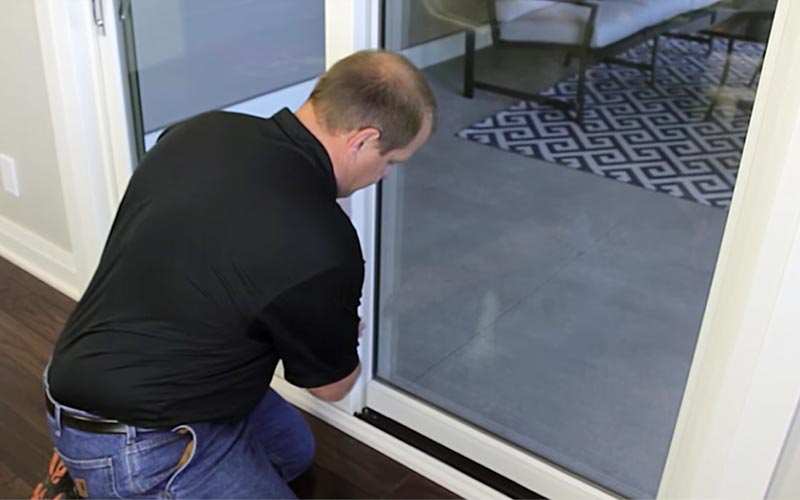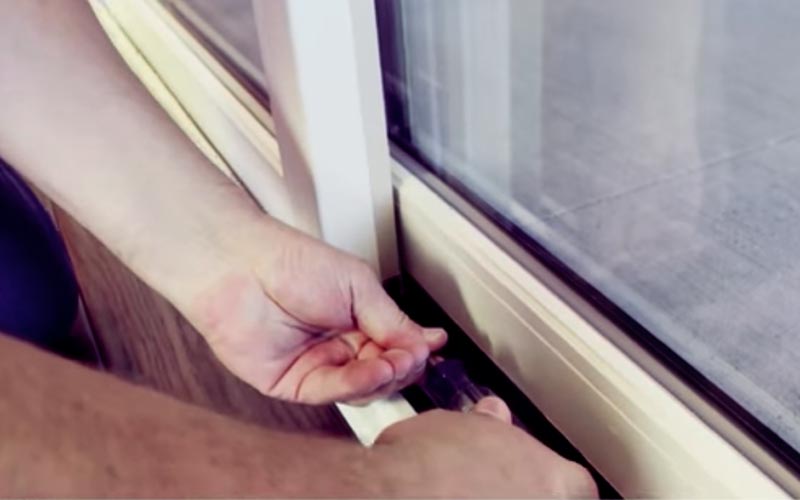Sliding doors do wonders for filling your home with natural light, letting the outside in and even getting fresh air circulating throughout your home. Because they’re integral to the design of your home, you’ll want to make sure they’re working safely and properly — here are the fixes for six of the most common problems.

A door that’s stuck or difficult to slide
According to This Old House, debris build-up is the main reason for a sliding door that refuses to glide. Dirt, mud, hair and fur can collect along the track and in the groove, which clogs the rollers underneath and prevents smooth motion. Here’s how you can clean the rollers and the track.
-
Remove the door from the track. First,Locate the roller adjustment screws and use a screwdriver to turn the screws counterclockwise. This will retract the rollers and make the door flush with the track. Then, remove the door stop at the top of the frame, which should be as simple as unscrewing it. Once those two steps are taken, you should be able to carefully remove the door from the track.
-
Check the rollers. Place the door on a pair of sawhorses for easy access to the rollers on the bottom. Use a screwdriver to gently pull the rollers out. If they appear to be damaged, that may be your problem — they’ll have to be replaced. If they’re simply dirty, scrape any dirt off, then rub them clean with denatured alcohol. You may want to re-oil them using silicone spray, which repels dirt.
-
Reinstall your clean rollers. Align each adjustment screw with the access hole and tap into place using a hammer and a wood block to prevent damage to the wheels. When they’re properly in place, retract the rollers as far as possible.
-
Clean the tracks. As with the rollers, wipe the top track with alcohol and spray with silicone. Vacuum loose debris from the bottom track, then clean with alcohol. However, you’ll want to lubricate the bottom track by rubbing it a few times with a block of paraffin wax instead of silicon — paraffin is more substantial and will hold up to the wear and tear the bottom track tends to take.
-
Reinstall your door. Align it in the bottom track and then tilt it up. Reattach the head stop first — otherwise it could fall out. Roll the door toward the latch-side jamb, then turn the adjustment screws until the door is parallel with the jamb.

You may also want to check out our step-by-step guide to adjusting your sliding doors.
Alignment problems
Most sliding doors manage to get knocked off-kilter at one point or another. To realign your door in the tracks at the top and bottom of the frame, remove the door from the track and reinsert it. Make sure the rollers at the top are aligned first, then “walk” the bottom of the door into place, pushing the top of the screen door up into the track. You may need to rotate the adjustment screws at the top slightly to allow for movement. When the door is back in place, make sure to re-adjust the screws.
Broken latches
Got a latch that won’t quite catch? If simply oiling it doesn’t work, you will likely have to replace the whole thing. Remove the lock, being careful not to drop it down into the body of the window, and take it with you to the hardware store to ensure that you purchase a compatible version. Install according to the directions on the lock you’ve purchased, then test your handiness by trying the key, turning the lever and checking to see that all pieces seem to be in proper working order. For instructions on installing other types of latches, visit DoItYourself.com.
Torn screens
Busted screens happen to the best of us. Whether a small child was a little less than delicate with your screen or you accidentally put your hand through it yourself, rest assured that replacing your screen isn’t too difficult. These step-by-step instructions from Popular Mechanics will walk you through the process.
Shattered glass
If the frame is fine, you certainly can replace the glass in your sliding glass door yourself, but unless you’re a DIY pro, we recommend leaving this one to the experts. However, if you feel confident in your home improvement skills, replacing the glass on a sliding door is much like replacing any other window.
-
Remove the trim around the glass, then carefully remove whatever glass remnants are left.
-
You’ll need to order a new piece of glass — to get the measurements right, measure the height and width of the opening, then subtract ¼-inch from each measurement.
-
Install the new piece by placing it into the opening and caulking into place.
-
Replace the trim you originally removed, then secure it with tacks.
-
Clean up any excess caulk and clean the glass.
A broken or bad seal
To fix weatherstripping that’s no longer protecting you from the elements, loosen its staples with a screwdriver, then pull it from the door, prying gently with a putty knife if necessary. Remove any additional staples or glue residue. Install the new weatherstripping as the directions indicate, making sure to orient the flap correctly. Use screws to secure the flange along the edge of the door. Glue the jamb-side strip in place with a plastic adhesive, then clean up any excess adhesive or smudges.
Of course, the best way to cut back on sliding glass door problems is to install quality products, which will last longer and stand up to more wear and tear. Windsor Windows & Doors has a wide variety of products that will work for your patio — check out our patio door options, read up on considerations to make before installing a patio door or find a dealer today.